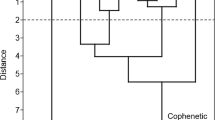Abstract
Amino acids and dipeptides that are correlated significantly with lipase optimum temperatures were searched for in 34 microbial lipase sequences by a stepwise regression method. The positive dipeptides were found to be IR, KS, NY, SA, ST and YR, whereas negative ones were DK, DY, IS, KA, WS, YS and QI. The calculated optimum temperatures from an optimal regression equation of dipeptides fitted the corresponding experimental optimum temperatures of lipases very well, and the maximal absolute difference was only 3.43°C. The spatial positions of the related dipeptides were searched for in two known crystal structures of a thermophilic and mesophilic lipase, respectively. Most of the positive dipeptides were sited in the α-helices, while the negative ones were located mainly in the β-strands or coils and about half of them existed in the N- or C-terminii of the lipases. The results obtained will be very useful in lipase engineering for enhancing lipase thermostability.


Similar content being viewed by others
References
Acharya P, Rajakumara E, Sankaranarayanan R, Rao NM (2004) Structural basis of selection and thermostability of laboratory evolved Bacillus subtilis lipase. J Mol Biol 341:1271–1281
Akoh CC, Lee GC, Shaw JF (2004) Protein engineering and applications of Candida rugosa lipase isoforms. Lipids 39:513–526
Anfinsen CB (1973) Principles that govern the folding of protein chains. Science 181:223–230
Brady L, Brzozowski AM, Derewenda ZS, Dodson E, Dodson GG, Tolley S, Turkenburg JP, Christiansen L, Huge-Jensen B, Norskov L, Thim L, Menge U (1990) A serine protease triad forms the catalytic centre of a triacylglycerol lipase. Nature 343:767–770
Chakravarty S, Varadarajan R (2000) Elucidation of determinants of protein stability through genome sequence analysis. FEBS Lett 470:65–69
Cote A, Shareck F (2008) Cloning, purification and characterization of two lipases from Streptomyces coelicolor A3. Enzyme Microb Technol 42:381–388
Declerck N, Machius M, Wiegand G, Hube R, Gaillardin C (2000) Probing structural determinants specifying high thermostability in Bacillus licheniformis alpha-amylase. J Mol Biol 301:1041–1057
Ding YR, Cai YJ, Zhang GX, Xu WB (2004) The influence of dipeptide composition on protein thermostability. FEBS Lett 569:284–288
Gatti-Lafranconi P, Caldarazzo SM, Villa A, Alberghina L, Lotti M (2008) Unscrambling thermal stability and temperature adaptation in evolved variants of a cold-active lipase. FEBS Lett 582:2313–2318
Han ZL, Han SY, Zheng SP, Lin Y (2009) Enhancing thermostability of a Rhizomucor miehei lipase by engineering a disulfide bond and displaying on the yeast cell surface. Appl Microbiol Biotechnol 85:117–126
Karplus PA, Schulz GE (1985) Prediction of chain flexibility in proteins, a tool of the selection of peptide antigens. Naturwissenschaften 72:212–213
Kawasaki K, Kondo H, Suzuki M, Ohgiya S, Tsuda S (2002) Alternate conformations observed in catalytic serine of Bacillus subtilis lipase determined at 13A resolution. Acta Crystallogr, Sect D: Biol Crystallogr 58:1168–1174
Klibanov AM (2001) Improving enzymes by using them in organic solvents. Nature 409:241–245
Li WF, Zhou XX, Lu P (2005) Structural features of thermozymes. Biotechnol Adv 23:271–281
Nelofer R, Ramanan RN, Rahman RNZRA, Basri M, Ariff AB (2011) Sequential optimization of production of a thermostable and organic solvent tolerant lipase by recombinant Escherichia coli. Ann Microbiol 61:535–544
Pack SP, Yoo YJ (2004) Protein thermostability: structure-based difference of amino acid between thermophilic and mesophilic proteins. J Biotechnol 111:269–277
Panasik JN, Brenchley JE, Farber GK (2000) Distributions of structural features contributing to thermostability in mesophilic and thermophilic α/β barrel glycosyl hydrolases. Biochim Biophy Acta 1543:189–201
Reddy BVB, Ramesh P, Tiwari S (1998) MEICPS: substitution mutations to engineer intracellular protein stability. Bioinformatics 14:225–226
Sayari A, Frikha F, Miled N, Mtibaa H, Alia YB, Verger R, Gargouri Y (2005) N-terminal peptide of Rhizopus oryzae lipase is important for its catalytic properties. FEBS Lett 579:976–982
Schrag JD, Li Y, Cygler M, Lang D, Burgdorf T, Hecht HJ, Schmid R, Schomburg D, Rydel TJ, Oliver JD, Strickland LC, Dunaway CM, Larson SB, Day J, McPherson A (1997) The open conformation of a Pseudomonas lipase. Structure 5:187–202
Sharma R, Soni SK, Vohra RM, Gupta LK, Gupta JK (2002) Purification and characterization of a thermostable alkaline lipase from a new thermophilic Bacillus sp RSJ-1. Process Biochem 37:1075–1084
Shi BH, Wu WB, Wen JX, Shi QQ, Wu SG (2010) Cloning and expression of a lipase gene from Bacillus subtilis FS1403 in Escherichia coli. Ann Microbiol 60:399–404
Vieille C, Zeikus GJ (2001) Hyperthermophilic enzymes: sources, uses, and molecular mechanisms for thermostability. Microbiol Mol Biol Rev 65:1–43
Acknowledgments
This work was supported by a grant from The National Natural Science Foundation of China (No. 20776061). We are grateful to Prof. Weida Huang (Department of Biochemistry, School of life Sciences, Fudan University) for providing technical assistance.
Author information
Authors and Affiliations
Corresponding author
Rights and permissions
About this article
Cite this article
Zhang, HM., Li, JF., Wu, MC. et al. Determination of amino acids and dipeptides is correlated significantly with optimum temperatures of microbial lipases. Ann Microbiol 63, 307–313 (2013). https://doi.org/10.1007/s13213-012-0475-y
Received:
Accepted:
Published:
Issue Date:
DOI: https://doi.org/10.1007/s13213-012-0475-y




